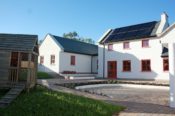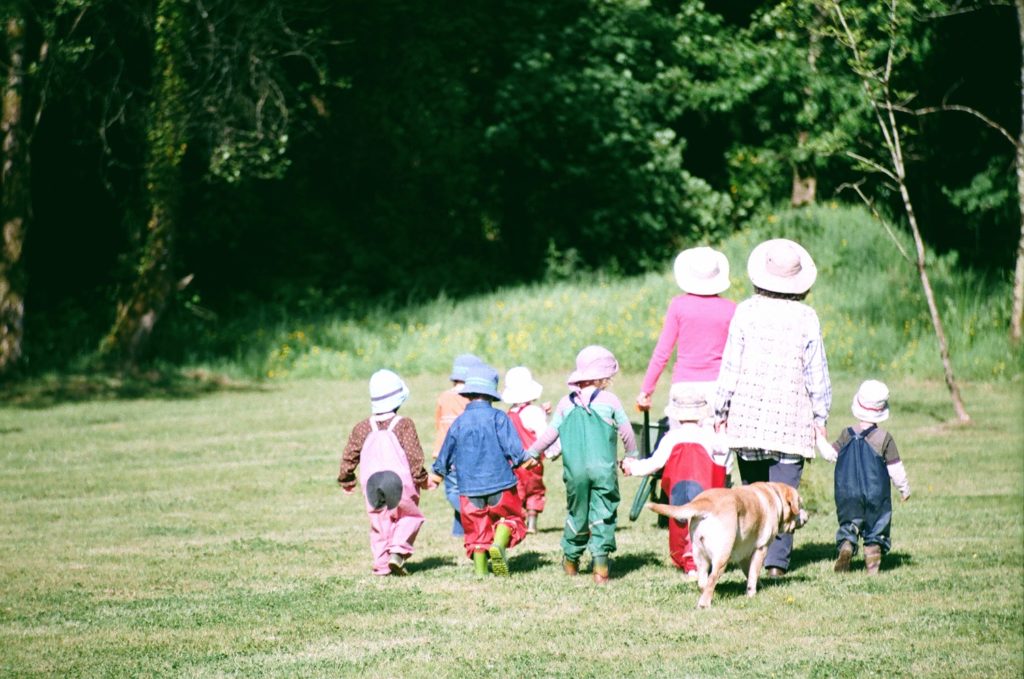Waldorf News
Goodbye to cooped-up creches: Making classrooms free-range: At the Steiner Brigit’s Hearth in Co Clare preschoolers learn from nature

By Manchán Magan
A pre-school in an eco-building on the edge of a native woodland in Co Clare sounds a little like a fairytale. Yet, that is precisely what Brigit’s Hearth in Tuamgraney, near Scarriff, is: a clay-walled early learning centre within the root-range of the ancient Brian Boru oak.
As a Government-funded community project, this Waldorf (Steiner) school is a model of what could be replicated throughout Ireland – where the arrivals hall for new babies is within an acorn’s drop of the departure lounge of a neighbouring nursing home, in an area of profound ecological richness.
That such a place exists is down to a vibrant Spaniard named Lina Pelaez who was involved with the Steiner primary school in Tuamgraney where she realised that the children arriving at its kindergarten at age four were already set in their ways. “We know that the first three years of life are the most important,” says Pelaez, “and the children coming to me were already confused and distressed. We were getting them too late.”
So, she and a Danish friend set up a pilot project to care for children up to three years of age, without any funds or backing. “We were given a room in a large farmhouse in return for helping with their laundry. We had an old orchard to play in and a big drawing room with a wood burning stove. The children loved playing with the laundry – getting inside the baskets, pulling things in and out.”
Pelaez recalled how Steiner, an Austrian who formulated the philosophy underpinning the schools, stressed the importance of domestic activities in the development of children. They called the project Brigit’s Garden and it continued for a few years, “until eventually I realised we couldn’t continue doing this without permanent premises”.
This was in 2007 when the government was flush and was offering generous capital funding for community projects.

“We applied and got close to €700,000, which was a total shock as I was packing to go back to Spain for good. I knew that if we were to build it, it would have to be with the same vision as we were doing our work with the children, and that getting planning permission for such a building would be a challenge.”
Pelaez spotted a three-acre field on the edge of Raheen Woods right beside the local nursing home and community hospital. “I knew the area well from visiting the Brian Boru oak which is probably 1,500 years old and I thought this was the ideal place. We kind of had to do it here.”
She met Brian O’Brien of Solearth Architecture and explained how she wanted to unite local traditions with environmental building solutions. “I had drawings of all these abandoned homesteads and thatch cottages that I had seen around.”
Clare County Council’s planning officers were understandably hesitant: “Not a hope, they said. Their vision of a crèche was not an archetypal rural homestead.”
The fact that the centre would be in the countryside was a particular hurdle, but Pelaez explained the importance of children experiencing the changing seasons and walking on uneven natural terrain, and how important it was to have free play outdoors and a healthy home-like environment.
“We showed them photos of our children playing outdoors and explained how the experience of goodness and beauty will stay with them forever. Even if they come from an underprivileged background they will search for these qualities in their later lives.”
In the end, planning permission was approved and over three years, Pelaez and her colleague Veronica Crombie supervised the construction of the clay-blocked buildings with waxed wooden floors, silicone-free plaster, solar panels and biological paints. The aim was to be as home-like and “un-institutional” as possible, with a large kitchen for preparing organic wholesome meals and a wood burning stove surrounded by quiet rooms, playrooms and an enclosed courtyard with a sandpit.
“We decorated with natural Irish things – prints by Irish artists, hand-loomed blankets and pieces by local craftsmen so that the children are surrounded by their native culture.”
By the end, Pelaez was exhausted and penniless and to lift her spirits a friend bought her a ticket to a concert in Feakle by local hero, Martin Hayes. She summoned the courage to ask him would he consider playing at the opening of the building and though he was busy putting his fiddle away, he told her to email him about it.
“Back then I was a bit like Snow White with my little ones around me walking in the woods with all the birds twittering and the leaves falling. My friends would say, ‘You’ll never meet anyone here, you’re too solitary. You need to get out more. And I thought ‘No,’ I’ll stay here where some prince will have to come and find me. When I saw Martin coming up the path a few weeks later it felt like the prince had arrived.”
Hayes played at the opening and a few months later phoned Pelaez from America to ask her to marry him. “But, I don’t know you,” she said. “Well, do you know my music?” he replied, “That’s who I am.” They now divide their time between Madrid, Clare and touring the world with one of Hayes’s musical commitments, the Gloaming, the contemporary Irish music group.
The centre, named Brigit’s Hearth, is thriving. There is nothing else quite like it in Ireland. The children spend two to three hours every day in the woods. “We say to the parents that there is no bad weather if you have the right gear. They commit to spending money on good silk and wool underwear, boots and woollen socks. We all sit on rugs and help each other put our boots and coats on because this fraternal relationship is the foundation of a healthy social life. Once they are outside they are free to make their own decisions, whether to climb a tree or just sit on the roots. We just guide them to respect nature and its creatures, by example.”
Brigit’s Hearth is a model of what early childhood education could be in Ireland. It has nonprofit charity status, as Pelaez believes that “caring for young children can never be a business and when it is, the children are paying for it”. The children are in mixed age groups so they get to experience the richness of that interaction and can learn from each other. Instead of plastic toys they have handmade dolls, seashells and a few wooden toys that have been passed down over 20 years, with the handprints of more than 400 children on them. “We clean and wax them, and they get used again and again.”
While Pelaez’s vision was key to the development of Brigit’s Hearth, its success she insists is “down to the perseverance, devotion and generosity of the carers who worked over 20 years for next to nothing, and the parents who showed such commitment in searching out a new alternative for their children”.
Ultimately, the hope is that centres such as this can produce a new generation of strong, imaginative youths who will demand a holistic form of early education, one that immerses young people in their natural surroundings and leaves them with vision, hope and courage.
From irishtimes.com

 Apply Today: New Cohort Starts Nov. 2025
Apply Today: New Cohort Starts Nov. 2025 Transforming Voices Worldwide
Transforming Voices Worldwide Roadmap to Literacy Books & Courses
Roadmap to Literacy Books & Courses Middle School Science With Roberto Trostli
Middle School Science With Roberto Trostli Caring for All Stages of Life
Caring for All Stages of Life Immersive Academics and Arts
Immersive Academics and Arts Full-Time Teacher Education
Full-Time Teacher Education Flexible preparation for your new grade
Flexible preparation for your new grade Association for a Healing Education
Association for a Healing Education Summer Programs - Culminating Class Trips
Summer Programs - Culminating Class Trips Train to Teach in Seattle
Train to Teach in Seattle Quality Education in the Heartland
Quality Education in the Heartland Everything a Teacher Needs
Everything a Teacher Needs Great books for Waldorf Teachers & Families
Great books for Waldorf Teachers & Families Bay Area Teacher Training
Bay Area Teacher Training ~ Ensoul Your World With Color ~
~ Ensoul Your World With Color ~ The Journey is Everything
The Journey is Everything
 Waldorf Training in Australia
Waldorf Training in Australia Jamie York Books, Resources, Workshops
Jamie York Books, Resources, Workshops Bringing Love to Learning for a Lifetime
Bringing Love to Learning for a Lifetime Waldorf-inspired Homeschool Curriculum
Waldorf-inspired Homeschool Curriculum Space speaks. Its language is movement.
Space speaks. Its language is movement. RSS Feeds
RSS Feeds